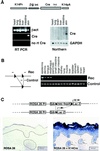The magical touch: genome targeting in epidermal stem cells induced by tamoxifen application to mouse skin
- PMID: 10411913
- PMCID: PMC17554
- DOI: 10.1073/pnas.96.15.8551
The magical touch: genome targeting in epidermal stem cells induced by tamoxifen application to mouse skin
Abstract
Gene knockout technology has provided a powerful tool for functional analyses of genes expressed preferentially in a particular tissue. Given marked similarities between human and mouse skin, such studies with epidermally expressed genes have often provided valuable insights into human genetic skin disorders. Efficient silencing of a specified gene in a temporally regulated and epidermal-specific fashion could extend functional analyses to broadly expressed genes and increase the categories of human skin disorders to which parallels could be drawn. We have generated transgenic mice expressing Cre and a fusion protein between Cre recombinase and the tamoxifen responsive hormone-binding domain of the estrogen receptor (CreER(tam)) under the control of the human keratin 14 (K14) promoter. This promoter is strongly active in dividing cells of epidermis and some other stratified squamous epithelia. With K14-Cre, transgenic embryos recombine genetically introduced loxP sequences efficiently and selectively in the genomes of keratinocytes that reside in embryonic day 14.5 skin, tongue, and esophagus. With K14-CreER(tam), postnatal transgenic mice show no Cre activity until tamoxifen is administered. If orally administered, tamoxifen activates keratinocyte-specific CreER(tam), allowing recombination of loxP sequences in epidermis, tongue, and esophagus. If topically administered, tamoxifen allows recombination in the area of skin where tamoxifen was applied. Finally, we show that epidermal cells harboring a Cre-dependent rearranged genome persist for many months after tamoxifen application, indicating that the epidermal stem cell population has been targeted efficiently. These tools now pave the way for testing the functional role of different somatic mutations that may exist in mosaic disorders of the skin, including squamous and basal cell carcinomas.
Figures



References
Publication types
MeSH terms
Substances
LinkOut - more resources
Full Text Sources
Other Literature Sources
Medical
Molecular Biology Databases
Research Materials
Miscellaneous

